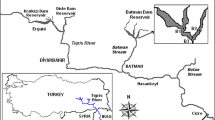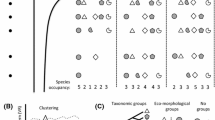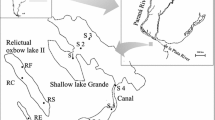Abstract
Two hundred and twenty-four phytoplanktonic taxa were recorded in a riverine floodplain on the NE side of the Doñana marshland from September 2002 to 2004. This collection of 11 samples included 80 Bacillariophyceae (Diatoms), 71 Chlorophyta, 39 Cyanophyta, 19 Euglenophyta, 6 Chrysophyceae, 5 Cryptophyta, and 4 Dinophyceae. Fifty-five percent of the total taxa had a very low frequency of appearance (<5%), while only three species appeared with a frequency >90% (Monoraphidium contortum Komárková-Legnevorá, Cyclotella atomus Hustedt, and Nitzschia palea W. Smith). According to multivariate analyses, both temporal and spatial factors produced a pattern in the phytoplankton assemblages dominated by freshwater inputs during winter flooding, tidal inputs in summer, and transitional stages during the rest of the year. Spatial segregation of phytoplankton was likely due to differences in retention time and distance to water input. The main taxa involved in this segregation were Chrysidalis sp. 1 (June 2003 and 2004), Chlamydomonas sp. 4 (September 2003), C. atomus (December 2003), and Tetradesmus aff. crocini (February 2004). The hydrologic complexity of the study area could account for this high taxa richness by promoting replacement and colonization episodes following seasonal changes in water source (freshwater versus tidal inputs).


Similar content being viewed by others
References
Comín, F. A., F. Menéndez, J. A. Romero, O. Hernández, M. Martínez & A. Chacón, 1999. Indicadores ecológicos y herramientas para la gestión de ecosistemas acuáticos en la zona costera. Limnetica 16: 61–68.
Comín, A. & I. Valiela, 1993. On the controls of phytoplankton abundance and production in coastal lagoons. Journal of Coastal Research 9: 895–906.
Cruz-Pizarro, L., I. De Vicente, E. Moreno-Ostos, V. Amores & K. El Mabrouki, 2003. Estudios de diagnósticos y viabilidad en el control de la eutrofización de las aguas de la Albufera de Adra. Limnetica 22: 135–154.
Gilabert, J., 2001. Seasonal plankton dynamics in a Mediterranean hypersaline coastal lagoon: the Mar Menor. Journal of Plankton Research 23: 207–217.
López-Flores, R., D. Boix, A. Badosa, S. Brucet & X. D. Quintana, 2006. Pigment composition and size distribution of phytoplankton in a confined Mediterranean salt marsh ecosystem. Marine Biology 149: 1313–1324.
Marín, C. & F. García-Novo, 2006. Doñana. Water and Biosphere. Spanish Ministry of Environment, Madrid.
Nuccio, C., C. Melillo, L. Massia & M. Innamorati, 2003. Phytoplankton abundance, community structure and diversity in the eutrophicated Orbetello lagoon (Tuscany) from 1995 to 2001. Oceanologica Acta 26: 15–25.
Odum, W. E., 1988. Comparative ecology of tidal freshwater and salt marshes. Annual Review of Ecology and Systematics 19: 147–176.
Puigserver, M., G. Ramon & G. Moya, 2002. Spatial and temporal distribution of phytoplankton in a Mediterranean Estuarine Canal System. Journal of Coastal Research 18: 39–51.
Quintana, X. D. & R. Moreno-Amich, 2002. Phytoplankton composition of Empordá salt marshes and its response to freshwater flux regulation. Journal of Coastal Research 36: 581–590.
Reyes, I., G. Martín, M. Reina, A. Arechederra, L. Serrano, M. A. Casco & J. Toja, 2007. Phytoplankton from NE Doñana marshland (“El Cangrejo Grande”, Doñana Natural Park, Spain). Limnetica 26: 307–318.
Reynolds, C. S., V. Huszar, C. Kruk, L. Naselli-Flores & S. Melo, 2002. Towards a functional classification of the freshwater phytoplankton. Journal of Plankton Research 24: 417–428.
Rodrigo, M. A., X. Armengol-Díaz, R. Oltra, M. J. Dasí & W. Colom, 2001. Environmental variables and planktonic communities in two ponds of El Hondo wetland (SE Spain). International Review of Hydrobiology 86: 299–315.
Rojo, C. & M. R. Miracle, 1989. Phytoplankton fluctuations during an annual cycle in the coastal lagoon of Cullera (Spain). Internationale revue der Gesamten Hydrobiologie 74: 179–194.
Romo, S., 1991. Estudio del fitoplancton de la Albufera de Valencia, una laguna hipertrófica y somera, entre 1980 y 1988. PhD Thesis, University of Valencia, Spain.
Romo, S., 1997. Importance of allochthonous phytoplankton in a coastal freshwater lake. Verhandlungen Internationale Vereinigung Limnologie 26: 610–614.
Romo, S. & M. R. Miracle, 1994. Population dynamics and ecology of subdominant phytoplankton species in a shallow hypertrophic lake (Albufera of Valencia, Spain). Hydrobiologia 273: 37–56.
Romo, S. & M. R. Miracle, 1995. Diversity of the phytoplankton assemblages of a polymictic hypertrophic lake. Archiv für Hydrobiologie 132: 363–384.
Sabater, S. & I. Muñoz, 1990. Successional dynamics of the phytoplankton in the lower part of the river Ebro. Journal of Plankton Research 12: 573–592.
Serrano, L., M. Reina, G. Martín, I. Reyes, A. Arechederra, D. León & J. Toja, 2006. The aquatic systems of Doñana (SW Spain): watersheds and frontiers. Limnetica 25: 11–32.
Sorokin, Y. I., F. Dallocchio, F. Gelli & L. A. Pregnolato, 1996. Phosphorus metabolism in anthropogenically transformed lagoon ecosystems: the Comacchio lagoons (Ferrara, Italy). Journal of Sea Research 35: 243–250.
Toja, J., G. Martín, E. Alcalá, C. Solá, A. Plazuelo, M. D. Burgos & I. Reyes, 2004. Efecto de la contaminación minera sobre el perifiton del río Guadiamar. Limnetica 23: 315–329.
Trigueros, J. M. & E. Orive, 2001. Seasonal variations of diatoms and dinoflagellates in a shallow, temperate estuary, with emphasis on neritic assemblages. Hydrobiologia 444: 119–133.
Villena, M. J. & S. Romo, 2003. Phytoplankton changes in a shallow Mediterranean lake (Albufera of Valencia, Spain) after sewage diversion. Hydrobiologia 506–509: 281–287.
Acknowledgements
We are very grateful to Pilar and Julio, to the rangers of Doñana Natural Park, and to our colleagues Gonzalo Martin, Arantza Arechederra, Marta Reina, David León, Virgilio Hermoso, Paco Blanco, and Pepe Prenda. This work was partly founded by the Consejería de Medio Ambiente, Junta de Andalucía.
Author information
Authors and Affiliations
Corresponding author
Additional information
Guest Editors: U.M. Azeiteiro, I. Jenkinson & M.J. Pereira
Plankton Studies
Rights and permissions
About this article
Cite this article
Reyes, I., Casco, M.A., Toja, J. et al. Hydrological complexity supports high phytoplankton richness in the Doñana marshland (SW Spain). Hydrobiologia 614, 47–54 (2008). https://doi.org/10.1007/s10750-008-9535-5
Published:
Issue Date:
DOI: https://doi.org/10.1007/s10750-008-9535-5




